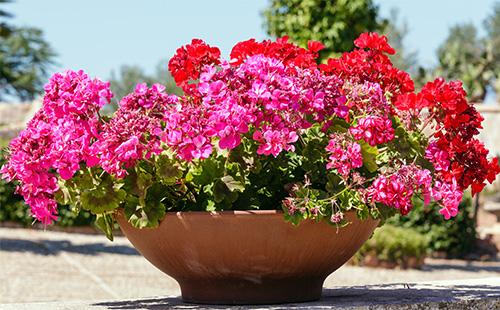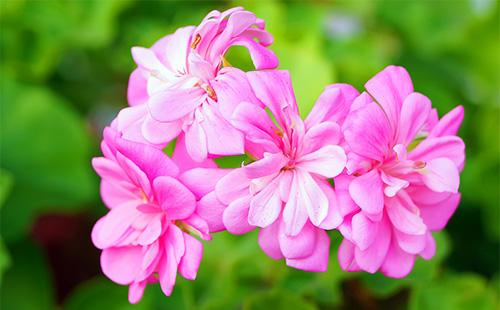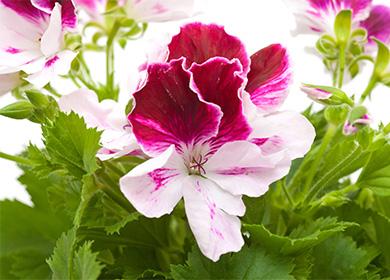The content of the article
Among all subspecies, pelargonium zonal is most common. The wide popularity is due to its longevity and abundant, long flowering. With good care and regular pruning, pelargonium does not lose its decorative effect until 20 years. Under natural conditions, it stretches up to 1 m. In apartments it forms compact bushes not exceeding half a meter. As the growth of the lower part of the shoots lignified.
Description and varieties
The name "zonal" this type of pelargonium received for the special coloring of the leaves. Depending on the variety, a lighter or darker strip passes along the edge of the leaves. Some varieties are decorated with spots of red-brown or purple.
Leaflets are mainly rounded in shape, covered with a short fluff. The stems are strong, well branched. The most common shade of flowers is red, but there are many hybrid varieties with inflorescences of all kinds of colors. Inflorescences are dense in the form of a magnificent cap.
Hybrid varieties are quite tall and dwarf. Tall species are sometimes formed in the form of a standard tree. It is easy to shape, after trimming it does not hurt.
Basic care
This is a simple, easy to grow plant. Compliance with the basic rules of care ensures its high decorativeness, lush and long flowering.
- Lighting. All types and varieties of pelargonium are demanding of light. In low light they do not bloom or form a small number of peduncles. Also, with a lack of light, the branches become thin and weak, the leaves are small and faded, the characteristic color is lost. The lower part of the stem is exposed. Pelargonium grows and blooms best on the south window. She is not afraid of the open sun - for full development, she must receive sunlight at least four hours a day. They are shaded only on especially hot days. In winter, it is advisable to illuminate artificially by placing lamps at a height of 10 cm above the plant.
- Temperature. Refers to heat-loving plants, does not withstand cooling below 8 ° C. In summer, the optimal temperature is considered to be 20-23 ° C in the daytime, at night from 13 to 15 ° C. Severe heat adversely affects the laying of flower buds. If the temperature often rises above 30 ° C, flowering will stop. In winter, they adhere to cooler conditions of detention: 18-20 ° C during the day, at night 12-13 ° C. The flower is fenced off from cold glass, drafts are avoided.
- Watering. Watering is recommended in moderation, but regularly. When dried, the leaves immediately turn yellow and fade, with excess moisture, the roots quickly rot. It is better to water in the morning, after waiting for the top layer of soil to dry. In winter, the frequency of watering is minimized - once every two weeks is enough.
- Air humidity. Pelargonium does not need high humidity. Spraying is an undesirable procedure. On velvety leaves of water, ugly spots may remain. Increasing humidity is required only during the heating season, when close to batteries.Pelargonium pot is placed in a tray with wet pebbles.
- Top dressing. Pelargonium can be fertilized with a complex preparation with a high content of potassium and phosphorus. This will have a beneficial effect on flowering. When choosing a fertilizer, they look at the concentration of nitrogen - it should be minimal. Lack of nutrients leads to leaf chlorosis. Pelargonium grows well and blooms if it is fed with fertilizer for tomatoes. A good effect is the introduction of the drug "Kemira-Lux." In the period of growth and flowering, fertilizers can be applied weekly, but reduce the dosage by two to three times. In winter, one feeding a month is enough.
- The soil. The soil should not contain too much humus, organic matter. In a soil rich in organic matter, green mass is rapidly gaining, flowering is weakening. The main requirements for the quality of the substrate are friability and breathability. You can use the soil for cacti, adding a little perlite to it or mix sand, sod, humus and leafy soil in equal proportions. Shredded charcoal is a healthy supplement. It prevents root decay as a result of overflow.
- Transfer. Germination of roots through drainage holes is a signal for transplantation. The frequency of transplants depends on the growth rate of a particular flower. You can transplant in any month of the growing season. Young, actively growing pelargoniums are transplanted twice a year. The pot is taken a little more - a half to two centimeters. With an excess of space, pelargonium does not bloom. Clay pots are chosen - they do not interfere with the full respiration of the root system.

Trimming and Shaping
To give the bush a neat shape, abundant and prolonged flowering, pelargonium is formed. Two methods are used - pruning and pinching.
Pinching is to remove the growth point. The tops are pinched for the development of young shoots from the axillary buds. Shoots become branched, lush, more flower stalks are formed on them. Pinch in the spring, at the very beginning of March. Young plants from the stem are nipped over the eighth or tenth leaf. When growing from seeds, it is better to pinch over the sixth leaf.
Pruning is a method of forming adult plants. Deformed and old shoots are cut off, leaving no more than five buds. Cut shoots are suitable as a material for cuttings. Crop in early spring. Experienced growers recommend a number of rules.
- Sterility. The knife must be sharp and sterile. Before use, it is scalded with boiling water and rubbed with alcohol. Nipping is carried out with clean, previously washed hands.
- Shine. After trimming and pinching, the pelargonium is kept in bright light. With a lack of light, young shoots will be thin and weak.
- Thinning. All shoots growing inside the bush are removed. Excessive density leads to disease.
- Slicing. Immediately after trimming, the slices are treated with coal powder, alcohol, and brilliant green.
Breeding
Propagation of zonal pelargonium by cuttings and seeds is practiced. The first method is considered more effective - flowering occurs faster, a young plant retains all the features of the mother bush.
Cuttings
Features Cuttings quickly let out roots and start to grow. Varietal characteristics of the plant are fully preserved. As cuttings, you can use the shoots remaining after trimming.
Procedure
- The slice is made at a slight angle under the leaf node. Lower leaves are removed.
- During the day, chopped cuttings are kept in a cool, shaded place.
- A mixture of sand and turf is poured at the bottom of the tank, only sand is in the upper layer.
- Moisten the substrate, cuttings are buried in it by 2-3 cm.
- To accelerate rooting, you can cover with a jar or a cut plastic bottle, but you need to constantly monitor humidity, remove accumulated condensate. Waterlogging will lead to decay of the cuttings.
Seed cultivation
Description. This gives better results than buying an adult plant. Seeds are used in stores. It is not recommended to collect seeds from hybrid plants - they lose the characteristics of a store plant. Only the strongest ones are selected from seedlings - good, healthy pelargoniums will grow from them.
Procedure
- To get flowering in the summer, the seeds are sown in mid-winter. An earlier sowing is also possible if it is possible to provide additional seedlings to the seedlings.
- The soil is light, sterile. Seeds are distributed on its surface, moistened with a spray bottle, sprinkled with a thin layer of dry soil or sand.
- The container with crops is kept in a warm, bright place, under a shelter of glass or polyethylene.
- Periodically slightly moisturize and remove condensation from the shelter.
- Sprouts appear in two to three weeks. They can be planted in separate pots at the stage of formation of three true leaves.

Problems, Diseases and Pests
Common pests of indoor plants, fungal and infectious diseases do not bypass pelargonium. Improper care weakens the plant, leading to a loss of decorativeness. The problems that you may encounter when growing a flower are reflected in the table.
Table - Problems in the cultivation of pelargonium and their causes
| Problem | Possible reasons |
|---|---|
| Leaves turn yellow and fall | - heat; - drying of the soil; - excessive watering; - oversaturation of soil with nitrogen; - The first signs of root rot; - mealybug (in the presence of white plaque in the axils of the leaves) |
| The edges dry and the lower leaves turn yellow | - The natural process of dying off the lower leaves; - malnutrition |
| Leaves fade, wet spots appear | Rot (stem) |
| No flowering, the plant turns yellow | - heat; - high humidity; - lack of food |
| Growth stops, the plant withers even with regular watering | - Close pot; - low acidity of the soil; - lack of nitrogen; - whitefly; - mealybug |
| The stems turn red, covered with brownish-red spots | - cold; - too bright sun; - rust |
| Black dots appear on the flower | Uneven irrigation with waterlogging and drying out of the soil |
| Leaves turn yellow in the center | Magnesium chlorosis |
| The edges of the leaves turn white and fade. | Nitrogen deficiency |
| The base of the stem darkens, rots | Blackleg |
| Leaves are drooping | - Drying of the soil; - fungus |
| Watery swelling forms on the foliage | - Irregular, uneven watering; - leaf edema |
| Grayish brown spots appear | - Gray rot; - fluffy coating |
| The flower does not grow, wither | - root rot; - root worm |
| A whitish coating appears on the leaves. | - Powdery mildew; - mealybug |
| The edges of the leaves turn brown, dry out | - excess phosphorus; - burn poor-quality or concentrated fertilizer |
Even with minimal care, the flower will look beautiful and bloom stably. Of interest is the wide color gamut of varieties.

